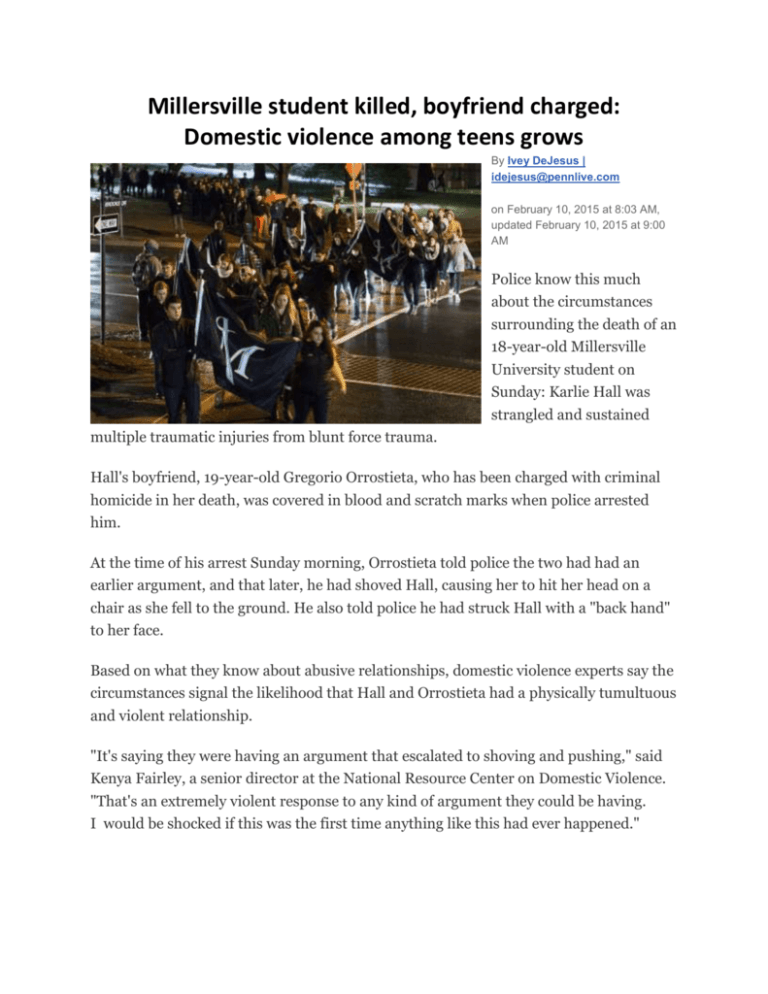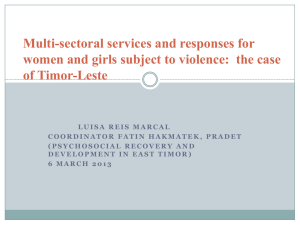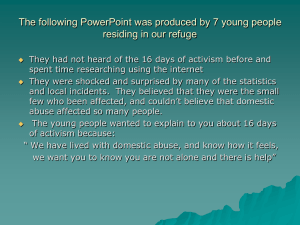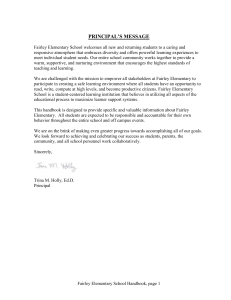
Millersville student killed, boyfriend charged:
Domestic violence among teens grows
By Ivey DeJesus |
idejesus@pennlive.com
on February 10, 2015 at 8:03 AM,
updated February 10, 2015 at 9:00
AM
Police know this much
about the circumstances
surrounding the death of an
18-year-old Millersville
University student on
Sunday: Karlie Hall was
strangled and sustained
multiple traumatic injuries from blunt force trauma.
Hall's boyfriend, 19-year-old Gregorio Orrostieta, who has been charged with criminal
homicide in her death, was covered in blood and scratch marks when police arrested
him.
At the time of his arrest Sunday morning, Orrostieta told police the two had had an
earlier argument, and that later, he had shoved Hall, causing her to hit her head on a
chair as she fell to the ground. He also told police he had struck Hall with a "back hand"
to her face.
Based on what they know about abusive relationships, domestic violence experts say the
circumstances signal the likelihood that Hall and Orrostieta had a physically tumultuous
and violent relationship.
"It's saying they were having an argument that escalated to shoving and pushing," said
Kenya Fairley, a senior director at the National Resource Center on Domestic Violence.
"That's an extremely violent response to any kind of argument they could be having.
I would be shocked if this was the first time anything like this had ever happened."
Reports of intimate partner violence among young people - which may or may not
involve sexual violence - has increasingly, in recent years, involved younger and younger
age groups.
According to a 2011 report from The Centers for Disease Control, a growing
number of young people under the age of 25 report experiencing rape, sexual assault,
physical violence and stalking from a significant partner. Particularly troubling is the
increase of young people between 11 and 17 reporting such incidents.
"The new term we are hearing from national groups is adolescent relationship abuse. It
is a reality with younger kids. They don't really date anymore but they are in
relationships," said Ellen Kramer of the Pennsylvania Coalition Against Domestic
Violence.
The numbers from the CDC are sobering: 1 in 10 teens report having been hit or
physically hurt by an intimate partner. Approximately 1.5 million high school-age teens
report having been victim of some abuse at the hands of a boyfriend or girlfriend.
Among college age students, 70 percent report having been sexually coerced. Adolescent
violence can begin as early as 12, and given that 72 percent of eighth and ninth graders
are dating, the numbers are troubling indeed.
"Young people are getting some real mixed messages from media, popular TV and music
as to what constitutes a healthy relationship," Kramer said. "So many people in these
abusive relationships don't understand what is a normal and healthy relationship and
don't have clear guidelines as to what their rights are in a dating relationship."
Fairley puts special blame on reality TV.
"Some young people are getting the notion that relationships have to be chaotic,
tumultuous and fill with drama," she said.
Far from being one-time arguments that precipitate rage or a so-called "crime of
passion," incidences of domestic and dating violence among young people often have
patterns of coercion, oppression and intimidation.
The definition of an abusive relationship among adolescents and young adults is broad.
Victims of abuse can be made to feel insulted, humiliated, controlled; they can be told
how to dress, coerced into sexual activity, be physically harmed, or kept from campus
activities or friends.
"It's a host of characteristics of a relationship when fitted together a young women can
start to see they can't be themselves and pursue what they want for themselves. A
healthy relationship goes parcel with that," Kramer said. "When you start to feel that
you have to 'check in' with your boyfriend or you are dealing with their insecurities or
temper or isolation, the red flag starts to go up. Those are sorts of red flags we want
young women to identify and reach out and get help."
Given their age, most young people in relationships lack the tools or maturity to foster
and define healthy relationships and healthy breakups.
"Relationships don't have to involve constant arguing or constant controlling," Fairley
said. "Healthy relationships don't involve someone shaming you for who you are,
whether it's related to appearance, the things you are interested in, family background
or community. That's not what healthy relationships look like."
A significant component of adolescent abuse is sexual coercion or intimidation.
"This can include being asked to do something or intimidated into doing something
seuxallly, whether it's dressing 'sexy,' or doing something you don't feel comfortable
about or exposing yourself," Fairley said. "Even things like having unprotected sex or
having sex with multiple partners."
This broad definition is compounded by technology, particularly that of texting and
messaging.
"What we observe in relationship is the abuser's ability to control a partner by
constantly texting or messaging 'where are you, why didnt you call me?'," Kramer said.
The intimidation behavior can go as far as the perpetrator installing tracking software
on the victims cell phone or laptop.
A young person's limited experience with relationships often determines how a young
victim understands what is happening and reports it, Fairley said.
In one study, approximately 57 percent of young victims waited six months or more to
get help. Most, Fairley said, need time to process what they are experiencing and put it
into perspective before seeking help.
Fear remains one of the biggest deterrents to reporting abusive situations. And that fear
can mean not only fear of being stigmatized or treated poorly by adults, but fear of
retribution by the abuser.
"There is real concern that the person who has been abusing them may become more
physically violent, or stalk the person or stalk members of their family and other
people," Fairley said. "There's a lot of valid fear in terms of when a person makes the
choice to report."
Experts stress that abusers are adept at "covering their tracks," whether that's
convincing friends of their victim that what they suspect is not really going on. For that
reason, close friends of the victim sometimes have only a partial picture of the situation.
Add to that the fact that abusers typically isolate their victims - meaning they keep them
from joining activities with friends or campus groups - and stalk and threaten them.
"That makes it harder for others to know what is going on and what is happening,"
Fairley said.
Intimate partner violence among young people knows no demographic boundaries,
experts say. Any person - regardless of race, gender, religion, socio-economic
background, ethnicity or sexual orientation - can become a victim or an abuser. That
victims suffer from low self-esteem is also a misconception.
"Anyone would have their self esteem deteriorate after experiencing days months of
being treated poorly by someone who says they love them," Fairley said.
CALL FOR HELP: LoveisRespect.org runs a national, confidential teen violence
hotline. Call 866-331-9474 or text "loveis" to 22522.












